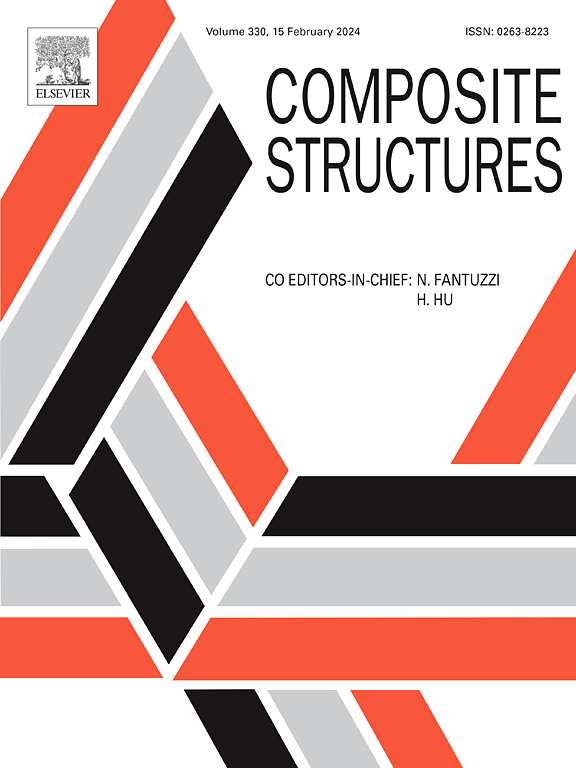Regularisation in Direct FE2 multiscale modelling of fused-filament fabricated parts
IF 6.3
2区 材料科学
Q1 MATERIALS SCIENCE, COMPOSITES
引用次数: 0
Abstract
This study investigated regularisation methods in Direct FE failure analysis of fused-filament fabricated (FFF) parts modelled as fibre-reinforced composites. Direct FE technique offers simplicity with moderate computational cost by incorporating microstructural variations of FFF parts into macroscopic constitutive behaviour. However, similar to conventional FE methods, loss of positive-definiteness in tangent stiffness matrix occurs at structural level because of the material-level strain localisation and softening behaviour. Further numerical complexity is added when element deletion technique (EDT) is employed; an aspect which remains unexplored for Direct FE. To address these issues, three regularisation methods (fracture energy, viscous, and combined schemes) were implemented in Direct FE analyses with EDT and their performance was evaluated in predicting the stiffness, strength, and deformation modes of poly(lactic) acid FFF parts with varying ductility. The results of Direct FE numerical analyses were compared to regular FE predictions and experimental tensile samples manufactured with different raster angles. It was found that unregularised Direct FE simulations suffered from convergence issues and the effectiveness of the regularisation method depended on material ductility, i.e., while some regularisation schemes could alleviate instabilities, others made an unrealistic prediction of failure mechanism. The combined regularisation approach was most effective in predicting ductile (0°) and moderately-ductile (mixed-mode, 45°) behaviour whereas fracture energy approach was best-suited for brittle failures (90°). The viscous regularisation tended to initiate EDT prematurely while combined regularisation provided more realistic depiction of microstructural deterioration.
熔断丝制件的直接FE2多尺度建模中的正则化
本文研究了纤维增强复合材料熔丝制造(FFF)部件的直接FE2失效分析的正则化方法。直接FE2技术通过将FFF零件的微观结构变化纳入宏观本构行为,提供了简单和适度的计算成本。然而,与传统的FE2方法类似,由于材料级应变局部化和软化行为,切向刚度矩阵的正确定性损失发生在结构级。采用元素删除技术(EDT)增加了数值复杂度;这是《Direct FE2》尚未探索的一个方面。为了解决这些问题,在EDT的Direct FE2分析中实施了三种正则化方法(断裂能、粘性和组合方案),并评估了它们在预测具有不同延性的聚乳酸FFF零件的刚度、强度和变形模式方面的性能。将Direct FE2数值分析结果与常规有限元预测结果和不同光栅角度的实验拉伸样品进行了比较。研究发现,非正则化的直接FE2模拟存在收敛性问题,且正则化方法的有效性取决于材料的延性,即一些正则化方案可以缓解不稳定性,而另一些则对破坏机制做出了不切实际的预测。组合正则化方法在预测延性(0°)和中等延性(混合模式,45°)行为时最有效,而断裂能方法最适合脆性破坏(90°)。粘性正则化倾向于过早地启动EDT,而组合正则化提供了更真实的微观组织恶化描述。
本文章由计算机程序翻译,如有差异,请以英文原文为准。
求助全文
约1分钟内获得全文
求助全文
来源期刊

Composite Structures
工程技术-材料科学:复合
CiteScore
12.00
自引率
12.70%
发文量
1246
审稿时长
78 days
期刊介绍:
The past few decades have seen outstanding advances in the use of composite materials in structural applications. There can be little doubt that, within engineering circles, composites have revolutionised traditional design concepts and made possible an unparalleled range of new and exciting possibilities as viable materials for construction. Composite Structures, an International Journal, disseminates knowledge between users, manufacturers, designers and researchers involved in structures or structural components manufactured using composite materials.
The journal publishes papers which contribute to knowledge in the use of composite materials in engineering structures. Papers deal with design, research and development studies, experimental investigations, theoretical analysis and fabrication techniques relevant to the application of composites in load-bearing components for assemblies, ranging from individual components such as plates and shells to complete composite structures.
 求助内容:
求助内容: 应助结果提醒方式:
应助结果提醒方式:


